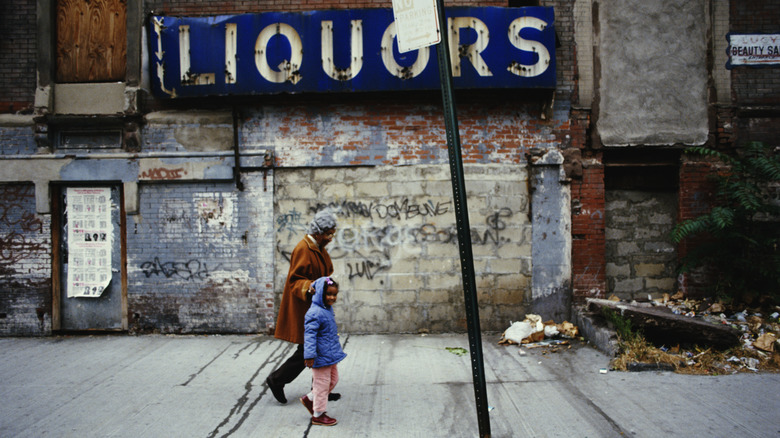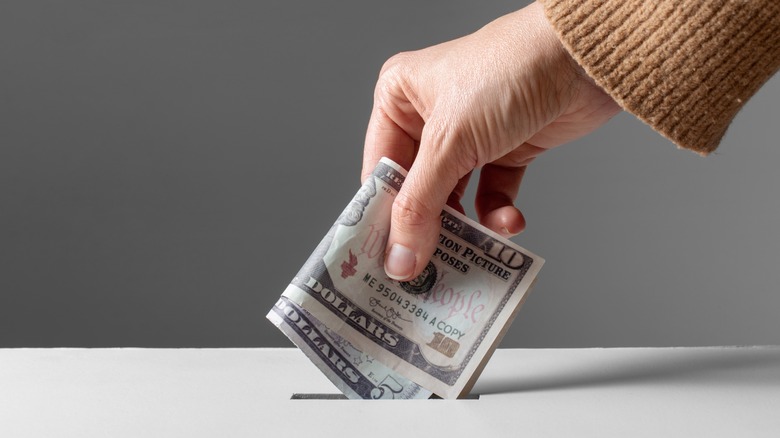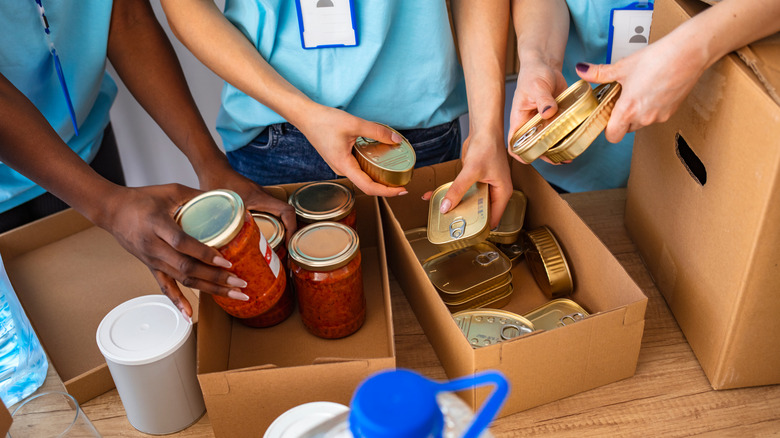The Biggest Charity Fraud Scandals In America
Americans give billions of dollars to charities every year, and let's be real — it's not entirely for unselfish reasons. We love the warm, fuzzy feeling we get knowing we helped feed a hungry child, house a disabled veteran, or get a little closer to a cure for childhood leukemia. We also kinda like the tax deductions. But generally speaking, we expect our charitable contributions to go to, you know, charities. That's ultimately the whole point.
Well, here's a news flash. Not all of your charitable dollars will make it into the hands of the people, animals, or border walls you thought you were supporting when you wrote that check, and that's true even when it's an above-board charity with a solid reputation. Like for-profit businesses, charities have operating costs that include advertising, payroll, utilities, and so on. But some so-called charities have a pretty creative interpretation of "operating expenses," and that's what separates the reputable ones from the scams.
Most of the "charities" you'll find on this list aren't operating anymore, or are operating after a total executive overhaul, so this isn't so much a warning about who not to donate to as it is a warning to be careful. Don't just sign over your paycheck to a robocaller — first, research the charity and make sure it's an A+ organization with a stellar reputation. And enjoy this cautionary tale of good-hearted donors who did not have the luxury of knowing who was on the other side of that fundraiser.
Associated Community Services
Let's start with a charity from the recent past, just so you won't be lulled into a false sense of security, thinking "that would never happen today." In the spring of 2021, the Federal Trade Commission (FTC) shut down a telefunding operation that turned out to be benefitting only about eight people, none of whom had any specific need for charitable contributions apart from a pathological desire to be wealthy.
Associated Community Services (ACS) was a robocall scheme, so the fraudsters were able to make an astonishingly huge number of calls — 1.3 billion of them, in fact, to roughly 67 million people. That means on average, each targeted person got 19 calls, though a few very unlucky numbers were called more than 5,000 times.
The FTC says ACS solicited money for noble causes like homeless veterans, children with autism, and breast cancer patients, but almost none of the money went to the actual, living people who were supposed to benefit from it. In fact, most of the organizations for which ACS was soliciting "spent little or no money on the charitable causes they claimed to support," and "little or no money" doesn't mean 5 or 10 cents on the dollar, it means one-tenth of 1%. Meanwhile, ACS' owners and executives kept around 90% of the money kind-hearted people got duped into handing over. Overall, the scheme netted about $110 million.
National Children's Leukemia Foundation
Nothing tugs the heartstrings like pictures of kids in hospitals, which is probably why St. Jude Children's Research Hospital was the third-ranking American charity in fiscal year 2021-22, getting around $2.42 billion in private donations (via Forbes). Unfortunately, emotional causes like sick children tend to inspire emotional giving, which isn't always the most rational kind of giving. Fraudsters know this and capitalize on it.
One such example is the National Children's Leukemia Foundation (NCLF), which was founded by a man who reportedly lost his own son to leukemia and therefore had an intimate understanding of what the families of leukemia patients need. NCLF took in around $9.7 million in charitable contributions, but according to CNN spent only $57,000 on assistance for leukemia patients. A whopping $1.3 million plus perks went directly into the pocket of NCLF's founder, that's right, the guy who lost his son.
According to Charity Watch, NCLF also told donors it had filed a patent application for a "lifesaving" leukemia treatment, but neither the patent nor the lifesaving leukemia treatment actually seemed to exist. Despite the founder's protestations that the charges had little merit, he later admitted to fundraising abuses and forfeited his pension, insurance benefits, and $600,000 in back pay. NCLF was finally shut down by the Office of the New York Attorney General in 2015.
The United States Navy Veterans Association
The United States Navy Veterans Association (USNVA) was founded by Harvard-trained attorney John Donald Cody, who claimed to be some guy named Bobby Thompson.
In 2013, Cody, aka Thompson, was sentenced to 28 years in prison for racketeering, theft, money laundering, and stealing people's identities including, evidently, Bobby Thompson's. According to its hideously ugly and practically unreadable archived website, USNVA was dedicated to supporting policies favorable to the U.S. Navy and helping "disabled and needy war veterans," hospitalized veterans, and the dependents and widows of deceased veterans. The organization also promised to sponsor or participate in "activities of a patriotic nature," which obviously meant engaging in the very American pastime of making as much money as possible at the expense of other people.
According to Charity Watch, USNVA told donors it was an old charity with 66,000 members and a bunch of local chapters. "Thompson" and his co-executives claimed to be veterans, which meant they could totally be trusted to use the funds wisely. And just to add a little frosting to the credibility cake, USNVA also claimed to have the support of multiple large foundations that didn't actually exist. In reality, there was just one guy: Cody, who collected around $100 million in donations. When he was finally apprehended, Cody had a suitcase full of almost $1 million in cash, but the rest of the money remains unaccounted for (via The Guardian).
Feed the Children
It's worth noting that Feed the Children (FTC) still exists, and is, according to Charity Navigator, a reputable organization with a four-star rating. So the scandal that plagued FTC in the past is now history.
According to Charity Watch, Feed the Children's woes centered around one dude: founder and former president Larry Jones, who famously liked to appear in the organization's infomercials also featuring malnourished children with flies on their faces. Jones led FTC for almost 30 years, during which time he managed to earn his charity the dubious reputation of "Most Outrageous Charity in America." During his tenure, employees reportedly used FTC's warehouse full of donated food as their own personal grocery store, and Jones' son used its bank account as his own personal ATM. Jones also wiretapped the charity's offices so he could record employees without their permission.
Jones' improprieties weren't quite on the grand scale of some other charity frauds, but he did give himself unauthorized raises, was accused of "misusing charity funds," and tried to stage a coup by installing a brand new, loyal-to-him board so the current one couldn't oust him. Perhaps most importantly, Jones caused long-term damage to FTC's reputation and the trust donors have for charitable organizations in general.
Hale House Foundation
Clara Hale lived through the Great Depression, single-handedly supporting herself and her three children as a house cleaner and janitor. Nicknamed "Mother Hale," she opened her home as a daycare for the children of the working poor and eventually became a foster parent and advocate for babies born addicted to heroin. When she died in 1992, Hale House was a substantial charity dedicated to caring for the children of drug-addicted mothers (via African American Registry). Hale left the charity in the care of her daughter Lorraine, and that's when everything fell apart.
According to the Los Angeles Times, Lorraine Hale and her husband used around $1 million of the charity's funds to buy themselves a Jacuzzi and fund an off-Broadway musical that no one actually ever saw. Some of the money was also used to pay family legal expenses unrelated to the Hale House itself. The couple also cashed in a $488,000 insurance policy to use for their own living expenses, per the New York State Attorney General.
Hale pled guilty to felony grand larceny and got five years probation, with an agreement that she and her husband would cooperate with authorities seeking to recoup the stolen funds (via New York Times). The lighter sentence was mostly due to Hale and her husband being in their 70s and not really great candidates for hard prison time.
Help Hospitalized Veterans and the Coalition to Salute America's Heroes
In 2006, Roger Chapin described himself as a "nonprofit entrepreneur" to Forbes, which frankly should have raised a whole bunch of red flags since a person can't make a profit and not make a profit at the same time. Chapin's "nonprofits" included an organization called Help Hospitalized Veterans (HHV) and another dubbed the Coalition to Salute America's Heroes (CSAH). HHV's mission was to provide "craft kits" to hospitalized veterans, so they'd have something more productive to do instead of just staring at a television. According to CNN, the "kits" were basically just instructions for making paper airplanes, which no one has to tell you is dumb with a capital D.
For their hard work on this obviously noble cause, executives received six-figure salaries, country club memberships, and the use of a suburban condo in Washington, DC, in case they needed a place to hang out and collaboratively design new paper airplanes (or something).
CSAH had a simpler goal: It was supposed to give financial assistance to wounded veterans and their families. But in 2007, Forbes reported the charity was playing fast and loose with accounting rules by sending its bills to HHV and double counting donations so it could falsely report a 97% fundraising efficiency. CSAH also gave Chapin $360,000 to cover "unreimbursed" expenses.
HHV is now Help Heal Veterans, and their mission is still pretty much the same, except they have better kits.
Police Survivors Fund
When someone dies suddenly and violently, family members are left in emotional and financial turmoil. The loss of that person may also mean a loss of income, and distraught people can't be expected to immediately pick up the pieces and find another way to pay the bills. Charities like the Police Survivors Fund are supposed to help remove some of that burden, giving families a chance to heal ... but, well, let's just say that the Police Survivors Fund failed to deliver on its promises.
According to Britannica, the Police Survivors Fund was established in 1999 with the supposed goal of providing money to the widows and children of police officers killed in the line of duty. During the charity's four years of operation, it collected $441,000, mostly through telephone solicitations. Worse, it used threats and intimidation to get people to cough up the money. Potential donors were told, for example, that their local police officers might not be in a hurry to come to their rescue if they weren't on record as Police Survivors Fund donors. They were also told that they had a patriotic duty to donate $911 to a fund commemorating the September 11, 2001, terrorist attacks, because you know, 9/11. In 2003, the ringleader of the Police Survivors Fund leader pleaded guilty to fraud and the fake charity was shut down (via AP).
We Build the Wall
One of Donald Trump's campaign promises was to build a "big, beautiful" border wall at the expense of the Mexican government. By October of 2020, that zero-dollar estimate was adjusted to around $15 billion, mostly from United States military funds (via Texas Tribune). That number was pretty hard for some people to stomach, so a few of Trump's supporters including Steve Bannon, Brian Kolfage, and Timothy Shea decided a little crowdsourcing was in order.
It's not really clear whether the "We Build the Wall" campaign was launched with good intentions or if it was only meant to line the pockets of its organizers, but according to the Department of Justice, the campaign raised more than $25 million, all of which was supposed to go to the border wall project. Instead, 350,000 donor dollars were siphoned into Kolfage's pocket under the cover of fake invoices and accounts. Bannon allegedly took around $1 million.
Kolfage pled guilty in 2022 and agreed to pay back $17 million (via BuzzFeed). According to the AP, Shea was convicted of two counts of conspiracy and one count of obstruction of justice for his part in the scheme. Bannon was pardoned by Trump but as of early 2023 still faced charges in the state of New York (via the Hill).
Foundation for New Era Philanthropy
You probably wish you could give more money to your favorite charity. In reality, though, everyone is sort of their own favorite charity, which means you're probably always going to need more money than you can give, no matter how worthy the cause. That's the weakness that the Foundation for New Era philanthropy exploited when it first began soliciting donations back in 1989.
According to the book "Faith-Based Fraud" (via Ministry Watch), New Era was basically a Ponzi scheme designed to mostly benefit its founder, a Christian businessman named John G. Bennett. Bennett told donors to stop giving to their favorite charities — instead, he said, they should give their money to New Era, which would double it, and then pass it along to the charity. Supposedly, Bennett had a fleet of wealthy anonymous donors willing to match contributions, which made the scheme seem plausible to the average person. It also actually did double a few contributions, which helped give it some early credibility. But it didn't last.
New Era took $135 million in charitable contributions, and Bennett himself used around $7 million for his own expenses. You know, for necessary stuff like a Lexus and $27,000 a week in "consulting fees" (via Charity Watch). It was only a few years before the scheme was found out. New Era filed bankruptcy and by 1998, Bennett was serving the first year of his 12-year prison sentence.
The American Cancer Society of Michigan (and 75 other fake charities)
It's pretty hard to get anything past the IRS, unless, apparently, you are running 76 individual fake charities. Yes, not only did the IRS approve all 76 of Ian Hosang's fake charities, but it also failed to notice that they all received mail at the same rented mailbox on Staten Island.
One of Hosang's fake charities had the reputable name "The American Cancer Society of Michigan," which made donors think it was the Michigan Branch of the American Cancer Society, and why should they believe otherwise? According to the New York Times, Hosang also got mail for the United Way of Ohio and 74 other fake non-profits at the same address.
Despite the relatively large number of fake charities Hosang was running, he didn't make himself fabulously wealthy, which might be why he flew under the radar for seven years. He solicited donors online and used their money to pay his mortgage and credit card bills, but only appears to have netted around $150,000 (via NBC New York). He was indicted in May of 2022, and if convicted will serve up to seven years in prison.
Angel Food Ministries (AFM)
Religious charities remain high on the list of America's favorite causes. According to Gallup, around 44% of U.S. adults donated money to religious organizations in 2021, and that's actually considered a historic low.
It's clear, however, that some people have a little too much faith in religious causes. Joe Wingo was a pastor, which probably made him easier to trust, though when he founded Angel Food Ministries (AFM) in 1994 it's unclear how many people knew he'd recently been in prison for extortion.
AFM's mission was to buy food and resell it at discounted prices to low-income people (via Charity Watch). Even the USDA seemed to think it was a good idea, giving AFM a low-interest loan in 2005. But by 2007, the feds were investigating Wingo, his wife, and their son, and four years later the trio was indicted for using charity funds to buy cars, electronics, sporting goods, and a jet. Well, to be fair, just the down payment on a jet. Wingo and his son each received a seven-year prison sentence and were ordered to pay back a total sum of $3.9 million.
Feeding Our Future
Feeding Our Future gets an honorable mention because this non-profit was not technically a charity and didn't get its money directly from willing donors. Instead, it got all its money from taxpayers, though let's face it — taxpayer money is basically just charitable donations we don't get a say in.
In September of 2022, the Justice Department announced federal charges against Feeding Our Future, which was supposed to use funds from the Federal Child Nutrition Program to feed underserved kids in the state of Minnesota but ... did not. Instead, the Justice Department says employees opened fake locations to serve fake meals to fake children, and submitted fake invoices so they could be reimbursed for all the fake food they bought. Hilariously, some of the fake kids they were feeding had names that were lifted from a website called listofrandomnames.com. They then took $18 million in administrative fees from the Federal Child Nutrition Program and used it to buy themselves luxury vehicles, real estate, and international vacations.
The scheme mostly took place during the early days of the pandemic, and the financial chaos of 2020 likely helped lend credibility to the idea that Feeding Our Future might actually be providing meals to half the city's school-aged children. At a news conference, U.S. Attorney Andrew Luger called the scheme "the largest pandemic fraud in the United States" (via Sahan Journal).












